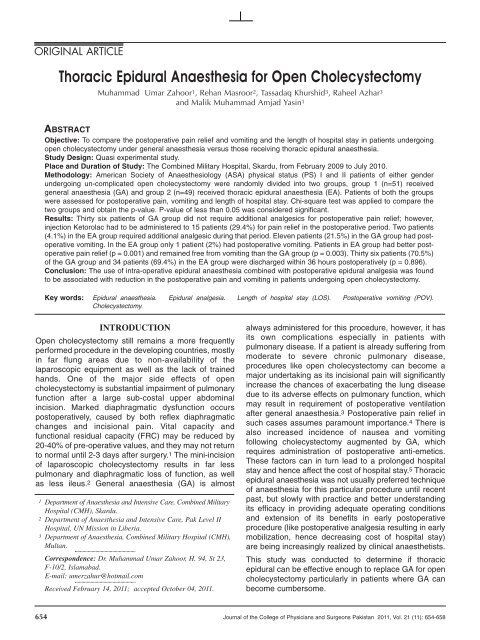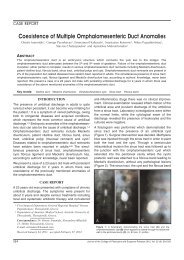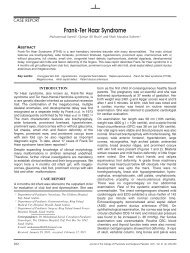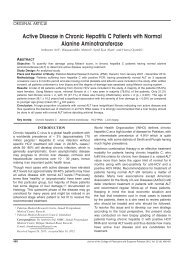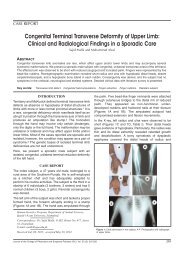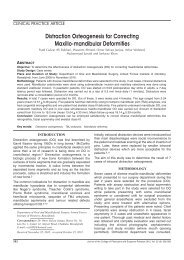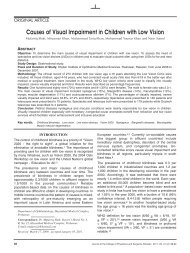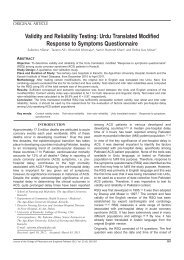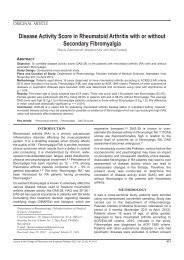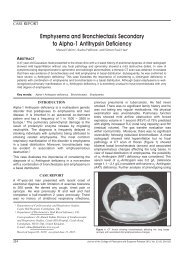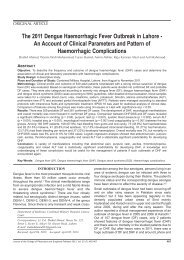Thoracic Epidural Anaesthesia for Open Cholecystectomy
Thoracic Epidural Anaesthesia for Open Cholecystectomy
Thoracic Epidural Anaesthesia for Open Cholecystectomy
You also want an ePaper? Increase the reach of your titles
YUMPU automatically turns print PDFs into web optimized ePapers that Google loves.
ORIGINAL ARTICLE<strong>Thoracic</strong> <strong>Epidural</strong> <strong>Anaesthesia</strong> <strong>for</strong> <strong>Open</strong> <strong>Cholecystectomy</strong>Muhammad Umar Zahoor 1 , Rehan Masroor 2 , Tassadaq Khurshid 3 , Raheel Azhar 3and Malik Muhammad Amjad Yasin 1ABSTRACTObjective: To compare the postoperative pain relief and vomiting and the length of hospital stay in patients undergoingopen cholecystectomy under general anaesthesia versus those receiving thoracic epidural anaesthesia.Study Design: Quasi experimental study.Place and Duration of Study: The Combined Military Hospital, Skardu, from February 2009 to July 2010.Methodology: American Society of Anaesthesiology (ASA) physical status (PS) I and II patients of either genderundergoing un-complicated open cholecystectomy were randomly divided into two groups, group 1 (n=51) receivedgeneral anaesthesia (GA) and group 2 (n=49) received thoracic epidural anaesthesia (EA). Patients of both the groupswere assessed <strong>for</strong> postoperative pain, vomiting and length of hospital stay. Chi-square test was applied to compare thetwo groups and obtain the p-value. P-value of less than 0.05 was considered significant.Results: Thirty six patients of GA group did not require additional analgesics <strong>for</strong> postoperative pain relief; however,injection Ketorolac had to be administered to 15 patients (29.4%) <strong>for</strong> pain relief in the postoperative period. Two patients(4.1%) in the EA group required additional analgesic during that period. Eleven patients (21.5%) in the GA group had postoperativevomiting. In the EA group only 1 patient (2%) had postoperative vomiting. Patients in EA group had better postoperativepain relief (p = 0.001) and remained free from vomiting than the GA group (p = 0.003). Thirty six patients (70.5%)of the GA group and 34 patients (69.4%) in the EA group were discharged within 36 hours postoperatively (p = 0.896).Conclusion: The use of intra-operative epidural anaesthesia combined with postoperative epidural analgesia was foundto be associated with reduction in the postoperative pain and vomiting in patients undergoing open cholecystectomy.Key words: <strong>Epidural</strong> anaesthesia. <strong>Epidural</strong> analgesia. Length of hospital stay (LOS). Postoperative vomiting (POV).<strong>Cholecystectomy</strong>.INTRODUCTION<strong>Open</strong> cholecystectomy still remains a more frequentlyper<strong>for</strong>med procedure in the developing countries, mostlyin far flung areas due to non-availability of thelaparoscopic equipment as well as the lack of trainedhands. One of the major side effects of opencholecystectomy is substantial impairment of pulmonaryfunction after a large sub-costal upper abdominalincision. Marked diaphragmatic dysfunction occurspostoperatively, caused by both reflex diaphragmaticchanges and incisional pain. Vital capacity andfunctional residual capacity (FRC) may be reduced by20-40% of pre-operative values, and they may not returnto normal until 2-3 days after surgery. 1 The mini-incisionof laparoscopic cholecystectomy results in far lesspulmonary and diaphragmatic loss of function, as wellas less ileus. 2 General anaesthesia (GA) is almost1 Department of <strong>Anaesthesia</strong> and Intensive Care, Combined MilitaryHospital (CMH), Skardu.2 Department of <strong>Anaesthesia</strong> and Intensive Care, Pak Level IIHospital, UN Mission in Liberia.3 Department of <strong>Anaesthesia</strong>, Combined Military Hospital (CMH),Multan.Correspondence: Dr. Muhammad Umar Zahoor, H. 94, St 23,F-10/2, Islamabad.E-mail: umerzahur@hotmail.comReceived February 14, 2011; accepted October 04, 2011.always administered <strong>for</strong> this procedure, however, it hasits own complications especially in patients withpulmonary disease. If a patient is already suffering frommoderate to severe chronic pulmonary disease,procedures like open cholecystectomy can become amajor undertaking as its incisional pain will significantlyincrease the chances of exacerbating the lung diseasedue to its adverse effects on pulmonary function, whichmay result in requirement of postoperative ventilationafter general anaesthesia. 3 Postoperative pain relief insuch cases assumes paramount importance. 4 There isalso increased incidence of nausea and vomitingfollowing cholecystectomy augmented by GA, whichrequires administration of postoperative anti-emetics.These factors can in turn lead to a prolonged hospitalstay and hence affect the cost of hospital stay. 5 <strong>Thoracic</strong>epidural anaesthesia was not usually preferred techniqueof anaesthesia <strong>for</strong> this particular procedure until recentpast, but slowly with practice and better understandingits efficacy in providing adequate operating conditionsand extension of its benefits in early postoperativeprocedure (like postoperative analgesia resulting in earlymobilization, hence decreasing cost of hospital stay)are being increasingly realized by clinical anaesthetists.This study was conducted to determine if thoracicepidural can be effective enough to replace GA <strong>for</strong> opencholecystectomy particularly in patients where GA canbecome cumbersome.654 Journal of the College of Physicians and Surgeons Pakistan 2011, Vol. 21 (11): 654-658
Muhammad Umar Zahoor, Rehan Masroor, Tassadaq Khurshid, Raheel Azhar and Malik Muhammad Amjad Yasinof Ketorolac 30 mg; however, the rest remained painfree(Table I). The difference in this group wassignificant, as the EA group showed less use of rescueanalgesia (p < 0.001).As to the occurrence of postoperative vomiting, 11patients (21.5%) in GA group had vomiting, whereasonly one patient (2%) in the EA group had vomiting(Table I). The difference was yet again significant(p = 0.003).In terms of the length of hospital stay, there was nosignificant difference between the groups (p = 0.896).(Table I).Table I: Table showing number of patients in both groups in terms ofpostoperative pain, postoperative vomiting and length ofhospital stay along with their p-values.GA EA p-valuegroupgroupPostoperative painRemained pain-free 36 47 < 0.001Required rescue medication 15 2Postoperative vomitingRemained vomiting-free 40 48 0.003Required antiemetic 11 1Length of hospital stayLess than 36 hours 36 34 0.896More than 36 hours 15 15DISCUSSIONGA is usually employed <strong>for</strong> open cholecystectomy as itprovides adequate surgical relaxation <strong>for</strong> the surgeryand usually more acceptable to the surgical colleaguesby convention. However, it can lead to a number ofcomplications especially if the patient is suffering fromany co-morbid condition. Tracheal intubation may triggerlife threatening spasms in patients of bronchial asthma.GA may result in need of postoperative ventilationconsiderably increasing LOS hence the cost of hospitalstay. Inadequate post-operative pain relief after GA canlead to abdominal muscle splinting and basal atelectasiscomplicating any concurrent lung disease while on theother hand it also delays out of bed mobilization, therebyresulting in prolonged postoperative ileus which cancause POV. POV is a significant cause of patientdistress requiring treatment and can result in prolongedLOS and adversely affect the economy of the surgicalprocedure.Many retrospective, prospective, and meta-analysisstudies have demonstrated an improvement in surgicaloutcome of EA through beneficial effects on perioperativepulmonary function, blunting the surgicalstress response and improved analgesia. 5-10 Inparticular, significant reduction in perioperative cardiacmorbidity (~30%), pulmonary infections (~40%),pulmonary embolism (~50%), ileus (~2 days), acuterenal failure (~30%), and blood loss (~30%) as well asbeneficial effects on immune system, cognition andprevention of peri and postoperative stress havebeen widely highlighted in the review of the literaturecarried out by us. 5-14 Despite all these above mentionedadvantages, regional anaesthesia in abdominalsurgeries, especially upper abdominal surgeries, isusually not preferred by most of the surgical colleaguesbecause first they are not accustomed to operate underthis type of anaesthesia and second because of thedelay associated with institution of this technique, hencean aspiring anaesthetist fails to establish thesetechniques into his/her practice as routine. 15Part of the problem lies with the anaesthetist, becausephysicians who desire to add regional anaesthesiatechniques to their own practice are most successful ifthey are fundamentally truly outstanding physicians and,as a result, excellent peri-operative physicians. Theymust be able to understand patient medical problems,surgeon's operative requirements, and regionalanaesthesia techniques, as well as recovery pattern,nursing requirements, rehabilitation and potentialcomplications from the surgical procedure per<strong>for</strong>med. 16Only if all of these are incorporated into decisionsabout regional anaesthesia will the patient, surgeon,anaesthesiologist, and nursing staff be co-advocatesof the proposed new technique. Regional (neuroaxial)anaesthesia is a commonly employed technique inroutine gyneacological and obstetric surgery in a typicalPakistan OT. This technique is successfully incorporatedin the authors routine general surgical practice as welland it is usually demanded by the surgical colleague ifan option. The perioperative period should be designedso that regional anaesthesia does not delay or slowdown a surgical day. Surgical delay is one of the mostimportant items to avoid if one desires to successfullyadd regional anaesthetic techniques to practice.This study was directed to find out if thoracic EA can beeffective enough to provide better pain relief in the postoperativeperiod, absence or reduced incidence ofvomiting and decreased hospital stay after surgery.These factors can be beneficial in preventingcomplications like Deep Vein Thrombosis (DVT) andpulmonary atelectasis. Furthermore, this can help limitthe use of opoids, NSAIDS or anti-emetics in the postoperativeperiod. Studies of high risk surgical patientsrandomized to EA plus GA or EA alone havedemonstrated fewer cardiac complications than inpatients provided GA. 7,17 These studies suggest thatthere is approximately a 4-fold reduction in theincidences of postoperative congestive heart failure,myocardial infarction, and death in patients treated withepidural local anaesthetics compared with those treatedwith balanced general anaesthetics. 18 The study provedthat not only patients who were given EA mobilized earlydue to better postoperative pain relief but also they656 Journal of the College of Physicians and Surgeons Pakistan 2011, Vol. 21 (11): 654-658
<strong>Thoracic</strong> epidural anaesthesia <strong>for</strong> open cholecystectomyexperienced less vomiting, providing greater patientsatisfaction. Nevertheless, in spite of these favourableresults no substantial difference was found amonggroups in the terms of LOS. Still, epidural anaesthesia/analgesia results in improved postoperative mortalityand decreased cost of care during the hospital stay ofthe patients. 15,19-23 Although this study has provenotherwise, retrospective studies have concluded thateffective epidural analgesia does affect length of stay. 15A large retrospective study of 462 consecutive cancerpatients undergoing surgery reported that both ICUdays (1.3 days versus 2.8 days, p < 0.05) and hospitallength of stay (11 days versus 17 days, P < 0.05) weredecreased in patients treated with perioperativeepidural anaesthesia/analgesia compared with thosetreated with general anaesthesia/intravenous (patientcontrol anaesthesia). 23No other study could be found in literature which hasstudied the effects of GA and EA on patients undergoingopen cholecystectomy. Only one study could be foundwhich has compared both <strong>for</strong>ms of anaesthesia onpatients undergoing laparoscopic cholecystectomy andhaving restrictive lung disease and found EA morefavourable. 24 In the postoperative period epidural topups gave superior pain relief than the opoids or NSAIDs.This leads to a less use of opoids and thus alsoprevented their potential side effects like nausea,vomiting and pruritis. Vomiting was also well controlleddue to early out of bed mobilization limiting the need ofanti-emetic. However, in terms of the LOS, no significantdifference could be detected.The overriding benefit of regional anaesthesiatechnique is that they do not need to end as the patientleaves the operating room at the end of the intraoperativeperiod and can be extended into postoperativeperiod to provide effective and economicalpain relief. In many cases, the surgical outcome of thepatient can be improved by implementing thoracicepidural anaesthesia/analgesia in perioperative periodand then extending it to the postoperative period <strong>for</strong> 48to 72 hours. The combination of epidural opoids andlocal anaesthetics provides superior analgesia thanwhen these drugs are used separately. The combinationdelivers superior analgesia on ambulation with addedadvantage of reduced toxicity than either class of drugalone. The epidural anaesthesia and analgesia reducesmorbidity due to thrombotic complications in complexvascular operations. A major advantage of thistechnique is shortened duration of postoperative ileusafter abdominal operations reducing the risk of POV,decreasing length of hospital stay and increased patientgratification. 25CONCLUSION<strong>Epidural</strong> anaesthesia is a reasonably safe and moreeconomical option <strong>for</strong> the patients undergoing upperabdominal surgery like open cholecystectomy. Due tothe benefit of its continuation in the early postoperativeperiod, it is really helpful in preventing the postoperativepain and vomiting. Although there did not appear anyapparent difference in the length of hospital stay butthere was a notable increase in patient satisfaction withthe EA as compared to GA, because of better quality ofpain relief and absence of POV. EA proved moreeconomical than GA in most of the cases.REFERENCES1. Bablekos GD, Michaelides SA, Roussou T, Charalabopoulos KA.Changes in breathing control and mechanics after laparoscopicvs. open cholecystectomy. Arch Surg 2006; 141:16-22.2. Gunnarsson L, Lindberg P, Tokics L, Thorstensson O, Thörne A.Lung function after open versus laparoscopic cholecystectomy.Acta Anaesthesiol Scand 1995; 39:302-6.3. Ballantyne JC, Carr DB, deFerranti S, Suarez T, Lau J,Chalmers TC, et al. The comparative effects of postoperativeanalgesic therapies on pulmonary outcome: cumulative metaanalysesof randomized, controlled trials. Anesth Analg 1998;86:598-612.4. Holte K, Kehlet H. Effect of postoperative epidural analgesia onsurgical outcome. Br J Anaesth 2001; 87:62-72.5. Grass JA. The role of epidural anaesthesia and analgesia inpostoperative outcome. Anesthesiol Clin North America 2000; 18:407-28, viii.6. Liu S, Carpenter RL, Neal JM. <strong>Epidural</strong> anaesthesia andanalgesia. Anesthesiology 1995; 82:1474-506.7. Park WY, Thompson JS, Lee KK. Effect of epidural anaesthesiaand analgesia on peri-operative outcome. A randomized,controlled Veterans affairs co-operative study. Ann Surg 2001;234:560-9; discussion 569-71.8. Groban L, Zvara DA, Deal DD, Vernon JC, Carpenter RL.<strong>Thoracic</strong> epidural anaesthesia reduces infarct size in caninemodel of myocardial ischemia and re-perfusion injury.J Cardiothorac Vasc Anesth 1999; 13:579-85.9. Yeager MP, Glass DD, Neff RK, Brinck-Johnsen T. <strong>Epidural</strong>anaesthesia and analgesia in high risk surgical patients.Anesthesiology 1987; 66:729-36.10. Rosenfeld BA, Beattie C, Christopherson R, Norris EJ, FrankSM, Breslow MJ, et al. The effects of different anaestheticregimens on fibrinolysis and the development of postoperativearterial thrombosis. Perioperative ischemia randomizedanaesthesia trial study group. Anesthesiology 1993; 79:435-43.11. Ballantyne JC, Carr DB, deFerranti S, Suarez T, Lau J,Chalmers TC, et al. The comparative effects of postoperativeanalgesic therapies on pulmonary outcome: cumulative metaanalysesof randomized, controlled trials. Anesth Analg 1998;86:598-612.12. Steinbrook RA. <strong>Epidural</strong> anaesthesia and gastrointestinalmotility. Anesth Analg 1998; 86:837-44.13. Procopio MA, Rassias AJ, DeLeo JA, Pahl J, Hildebrandt L,Yeager MP. The in vivo effects of general and epiduralanaesthesia on human immune function. Anesth Analg 2001;93:460-5.14. Rigg JR, Jamrozik K, Myles PS, Silbert BS, Peyton PJ, ParsonsRW, et al. <strong>Epidural</strong> anaesthesia and analgesia and outcome ofmajor surgery: a randomized trial. Lancet 2002; 359:1276-82.Journal of the College of Physicians and Surgeons Pakistan 2011, Vol. 21 (11): 654-658 657
Muhammad Umar Zahoor, Rehan Masroor, Tassadaq Khurshid, Raheel Azhar and Malik Muhammad Amjad Yasin15. Rosenquist RW, Brown DL. Incorporating regional anaesthesiainto anaesthetic practice. In: Longnecker DE, editor.Anaesthesiology. New York: McGraw-Hill; 2008. p. 974-7.16. Viscusi ER. Emerging techniques in the management of acutepain: epidural analgesia. Anesth Analg 2004; 101:S23-9.17. Beattie WS, Buckley DN, Forrest JB. <strong>Epidural</strong> morphine reducesthe risk or postoperative myocardial ischemia in patients withcardiac risk factors. Can J Anaesth 1993; 40: 532-541.18. de Leon-Casasola OA, Lema MJ, Karabella D, Harrison P.Postoperative myocardial ischemia: epidural versus intravenouspatient-controlled analgesia. A pilot project. Reg Anesth 1995;20:105-12.19. Carli F, Mayo N, Klubien K, Schricker T, Trudel J, Belliveau P.<strong>Epidural</strong> analgesia enhances functional exercise capacity andhealth-related quality of life after colonic surgery: results of arandomized trial. Anesthesiology 2002; 97:540-9.20. Bradshaw BG, Lui SS, Thirlby RC. Standardized perioperativecare protocols and reduced length of stay after colon surgery.J Am Coll Surg 1998; 186:501-6.21. Buggy DL, Smith G. Editorial. <strong>Epidural</strong> anaesthesia andanalgesia: better outcome after major surgery? Growingevidence suggest so. BMJ 1999; 319:530-1.22. Johnstone RE, Martinec CL. Costs of anaesthesia. Anesth Analg1993; 76:840-8.23. Kehlet H, Wilmore DW. Multimodal strategies to improve surgicaloutcome. Am J Surg 2002; 183:630-41.24. Rodgers A, Walker N, Schug S, McKee A, Kehlet H, van ZundertA, et al. Reduction of postoperative mortality and morbidity withepidural or spinal anaesthesia: results from overview ofrandomized trials. Br Med J 2000; 321:1493.25. Moraca RJ, Sheldon DG, Thirlby RC. The role of epidural anaesthesiaand analgesia in surgical practice. Ann Surg 2003; 238:663-73.l l l l lOl l l l l658 Journal of the College of Physicians and Surgeons Pakistan 2011, Vol. 21 (11): 654-658


